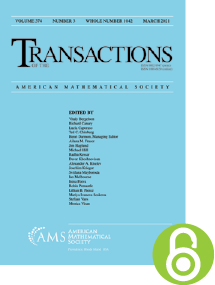Above and below subgroups of a lattice-ordered group
HTML articles powered by AMS MathViewer
- by Richard N. Ball, Paul Conrad and Michael Darnel PDF
- Trans. Amer. Math. Soc. 297 (1986), 1-40 Request permission
Abstract:
In an $l$-group $G$, this paper defines an $l$-subgroup $A$ to be above an $l$-subgroup $B$ (or $B$ to be below $A$) if for every integer $n$, $a \in A$, and $b \in B$, $n(|a| \wedge |b|) \leqslant |a|$. It is shown that for every $l$-subgroup $A$, there exists an $l$-subgroup $B$ maximal below $A$ which is closed, convex, and, if the $l$-group $G$ is normal-valued, unique, and that for every $l$-subgroup $B$ there exists an $l$-subgroup $A$ maximal above $B$ which is saturated: if $0 = x \wedge y$ and $x + y \in A$, then $x \in A$. Given $l$-groups $A$ and $B$, it is shown that every lattice ordering of the splitting extension $G = A \times B$, which extends the lattice orders of $A$ and $B$ and makes $A$ lie above $B$, is uniquely determined by a lattice homomorphism $\pi$ from the lattice of principal convex $l$-subgroups of $A$ into the cardinal summands of $B$. This extension is sufficiently general to encompass the cardinal sum of two $l$-groups, the lex extension of an $l$-group by an $o$-group, and the permutation wreath product of two $l$-groups. Finally, a characterization is given of those abelian $l$-groups $G$ that split off below: whenever $G$ is a convex $l$-subgroup of an $l$-group $H$, $H$ is then a splitting extension of $G$ by $A$ for any $l$-subgroup $A$ maximal above $G$ in $H$.References
- Richard N. Ball, Convergence and Cauchy structures on lattice ordered groups, Trans. Amer. Math. Soc. 259 (1980), no. 2, 357–392. MR 567085, DOI 10.1090/S0002-9947-1980-0567085-5
- Richard N. Ball, The generalized orthocompletion and strongly projectable hull of a lattice ordered group, Canadian J. Math. 34 (1982), no. 3, 621–661. MR 663307, DOI 10.4153/CJM-1982-042-5 —, The structure of the $\alpha$-completion of a lattice ordered group, Pacific J. Math. (submitted).
- Richard N. Ball, Topological lattice-ordered groups, Pacific J. Math. 83 (1979), no. 1, 1–26. MR 555035
- Alain Bigard, Groupes archimédiens et hyper-archimédiens, Séminaire P. Dubreil, M.-L. Dubreil-Jacotin, L. Lesieur et G. Pisot: 1967/68, Algèbre et Théorie des Nombres, Secrétariat mathématique, Paris, 1969, pp. Fasc. 1, Exp. 2, 13 (French). MR 0250950
- Alain Bigard, Klaus Keimel, and Samuel Wolfenstein, Groupes et anneaux réticulés, Lecture Notes in Mathematics, Vol. 608, Springer-Verlag, Berlin-New York, 1977 (French). MR 0552653
- J. W. Brewer, P. F. Conrad, and P. R. Montgomery, Lattice-ordered groups and a conjecture for adequate domains, Proc. Amer. Math. Soc. 43 (1974), 31–35. MR 332616, DOI 10.1090/S0002-9939-1974-0332616-X R. D. Byrd, Lattice ordered groups, Thesis, Tulane University, 1966. P. Conrad, Lattice ordered groups, Lecture Notes, Tulane University, 1970.
- Paul Conrad, Lex-subgroups of lattice-ordered groups, Czechoslovak Math. J. 18(93) (1968), 86–103 (English, with Russian summary). MR 225697 —, The structure of an $l$-group that is determined by its minimal prime subgroups, Ordered Groups, Lecture Notes in Pure and Appl. Math., vol. 62, Dekker, New York, 1980.
- Paul Conrad, John Harvey, and Charles Holland, The Hahn embedding theorem for abelian lattice-ordered groups, Trans. Amer. Math. Soc. 108 (1963), 143–169. MR 151534, DOI 10.1090/S0002-9947-1963-0151534-0
- A. M. W. Glass, Ordered permutation groups, London Mathematical Society Lecture Note Series, vol. 55, Cambridge University Press, Cambridge-New York, 1981. MR 645351 S. McCleary, Closed cls of a normal valued $l$-group...
- E. B. Scrimger, A large class of small varieties of lattice-ordered groups, Proc. Amer. Math. Soc. 51 (1975), 301–306. MR 384644, DOI 10.1090/S0002-9939-1975-0384644-7
Additional Information
- © Copyright 1986 American Mathematical Society
- Journal: Trans. Amer. Math. Soc. 297 (1986), 1-40
- MSC: Primary 06F15; Secondary 20E22
- DOI: https://doi.org/10.1090/S0002-9947-1986-0849464-7
- MathSciNet review: 849464


